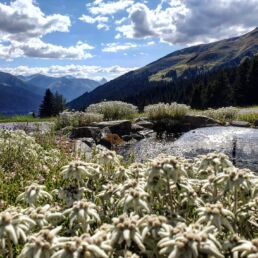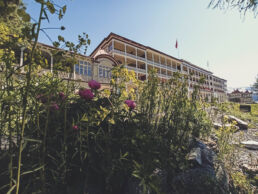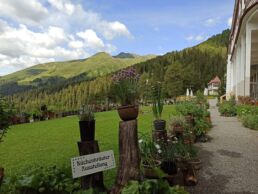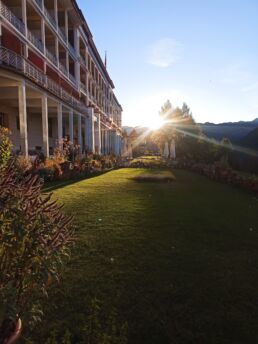The Gardens
Thomas Mann Square

The Gardens
The Thomas Mann Platz was laid out in 2007/08.
It is one of the coldest places on the Schatzalp. In some years the snow lies until the end of May.
Thomas Mann knew Karl Foerster and was enthusiastic about Foerster’s Larkspur (Delphinium) breeds. Delphiniums come from the mountains and thrive particularly well here.
Foerster was already in 1894, before the sanatorium was built, to go sledging on the Schatzalp. In the spirit of Foerster’s ”Harp and Timpani”, a small collection of rhubarb (Rheum) joins the delphinium in this garden. Further analogies to the cool Thomas Mann place were found in South Africa. Torch lilies bloom in October, often with snow caps, in this much-visited square.
Big Five Garden

The Gardens
In our so called Big Five Garden we have planted part of our collection of 5 large-flowered tall perennials. In our heart of the lower gardens, Irises (Iris), Peonies (Paeonia), day lilies (Hemerocallis), Larkspur (Delphinium) and oriental poppies (Papaver) can be admired in all their glory from June to October. Of course, in addition to plenty of accompanying and additional planting. The winding, small paths make this hillside garden something very special, especially in the evening hours. Discover this variety of horticultural breeding free of charge on the south side of the hotel.
Guggerbachtal-Alpinum
The Gardens
The foundation in this section is our rich endemic Flora, which is to be seen alongside the easy walkable paths in the area of the Schatzalp.
Alongside is a wide range of alpine and other plants from diverse mountain ranges, of those we where able to cultivate succesfully in the geologically diverse area of the Guggerbachtal.
We have succeeded in establishing a planting that delights our visitors from early mountain spring to late autumn with its changing colours and shapes. The stream Guggerbach has carved a steep valley from the Strelasee to Davos Platz, which provides all necessary and desireable requirements for a diverse alpine garden.
The Guggerbachtal-Alpinum is divided into two large areas, a natural area and a more cultivated (intensive) area. In the more natural part of the garden we find the natural vegetation with many different biotope types. Divided into smaller and larger plantations. The plant collections are planted according to species and location. The intensively tended and planted areas are embedded in the local flora like a mosaic and are themed. In general, a broader collection of wild types is planted here. However, horticultural wild selection also played a role right from the start of the garden.
Along the stream (Guggerbach) a steep path leads upwards, from which various circular routes into the Guggerbach valley open up. On this patch, the plant collections can be conveniently viewed from many sides. The steep slope was intercepted with a crevice garden in which guests can support themselves with built-in handrails. Small seats and information boards invite you to linger, take photos and learn. Immediately after the entrance gate, the so-called Swiss flora begins on the left along the stream and accompanies the guest upwards. On the right side of the path, it begins with a grove of cranesbill-hostas (geranium-hosta), which finally turns into wet meadow slopes. Above all, primroses (Primula) grow here, but also Irises (Iris), Gentians (Gentiana), cotton grasses etc. in the drier area further up, various blue poppy (Meconopsis) species are planted.
From the middle of June new flowers can be discovered every day. Passing steppe-like plantings, in which a pumice garden with rare primroses (Primula), bluebells (Campanula), and saxifrages (Saxifraga) is embedded, we enter the center of the garden. Various plant collections, such as cinquefoils (Potentilla), Irises (Iris) and Bergenia, are planted alongside the path. Following the path to the left, we walk through the “Cabinet of Rarities”, in which we show plants from all mountains in the world. The individual small garden areas are signposted and tell the guest something about crevice gardens, the Caucasus, the Appalachian Mountains and Tibet. But if we keep to the right, up the hill, we pass through a tall perennial flora which surrounds the cabinet of rarities (centre) and continues upwards through the entire garden. In these areas we collect the poisonous monkshood (Aconitum), Delphiniums (Delphinium), Lilies (Lilium), Peonies (Paeonia), meadow rue (Thalictrum) and much more. Spring, summer and autumn gentians grow along the wayside. On the way to the upper part of the garden, the flora of the western USA is to be shown in the future. If we follow the path, it leads us past a small shrub garden, through the Seslerietum to an Edelweiss (Leontopodium) collection, to a butterfly garden. At the top of the waterfall, the Alpinum can be left.
But if you haven’t seen enough yet, simply stroll back along the strea to the main entrance in several laps surrounded by clouds of blue Butterflies
Kitchen Garden

The Gardens
The kitchen garden at the hotel entrance, together with the culinary herb exhibition on the south side of the hotel, includes a large number of around 350 species and varieties of various medicinal and useful plants. They are not only used by our kitchen staff for your convenience, but are also available for your own viewing or as a guided event (culinary herb aperitif). You can also feast on the variety of our 6-course herbal menu.
Art Nouveau Garden

The Gardens
The parts of our garden, which are located directly at the Art Nouveau Hotel Schatzalp, are combined in our so called Art Nouveau Garden. These include the 2 large beds at the east and west solariums, the small lady’s slipper garden, the long hotel beds and of course the round bed with the historical Iris varieties (Iris Hybrids). In this part of the garden we prioritise cultivated types, plants that have been artificially bread. As in all lower parts of the garden, entry is free.
If you would like to find out more, visit our tour on wednesdays.
Historical Alpinum

The Gardens
The historical Alpinum was first mentioned in a newspaper article in 1907. At that time the hotel building was used as a sanatorium for Tuberculosis suffers. This part of the garden was used by the patients for local recreation. Here they could marvel at the variety of the adjacent Strela mountains and use it for recovery. Today, this part of the garden, which can be visited free of charge, is the heart of the lower part of the garden, together with the Big Five Garden. Visit our Wednesday guided tour.
If Wednesday is not an option for you, but you are interested in a private booking, look here or write to us.
You can find our other program here or simply contact alpinum@schatzalp.ch.




